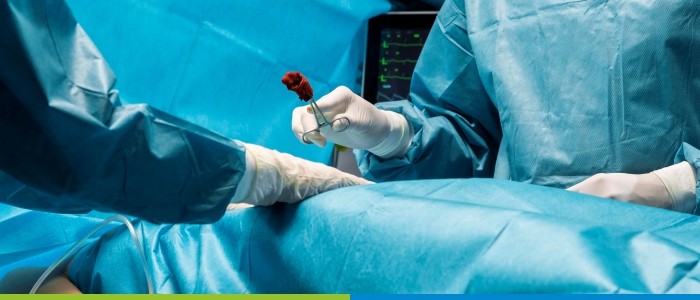Safe and Effective: Lap Appendicectomy for Swift Recovery

Appendicectomy Overview
Appendicectomy: Appendicitis is an inflammatory condition of the appendix. It has become a fairly common disease that most people are familiar with. With a fast-progressing disease like appendicitis, time is of the essence; delaying intervention for appendicitis may even lead to death.
Advancements in research and technology have allowed surgeons to move from traditional, open surgery to minimally invasive techniques for treating appendicitis, which are far more reliable, allow faster recovery, and have minimal chances of developing complications. Amidst the debate between laparoscopic vs open appendectomy, the laparoscopic procedure has become the norm for treating appendicitis by removing the appendix with minimal incision in the skin.
Symptoms of Appendicitis: What are the Indications for Laparoscopic Appendicectomy?
Laparoscopic or lap appendicectomy surgery can exhibit a range of symptoms which may differ in severity. Some of the common symptoms that may indicate the need for laparoscopic appendectomy include:
- Pain in the right lower abdomen, which may worsen during walking or coughing,
- Fever usually occurs within several hours,
- Loss of appetite,
- Nausea and/or vomiting,
- Constipation,
- Chills or shaking.
Treatment Options for Appendicitis
Appendicectomy is the standard surgical procedure for appendicitis, which involves removing the appendix. Since appendicitis has the potential to rupture, it is considered to be a medical emergency. A burst appendix can spread infectious agents throughout the abdominal cavity, leading to peritonitis, an inflammation of the abdominal lining. If the infection has spread to the bloodstream, it can lead to sepsis, a serious, life-threatening systemic illness of the body. The appendix ruptures within the first 36 hours of appendicitis, so it is imperative not to delay treatment for appendicitis.
In some cases, some people may respond well to antibiotics alone if their appendicitis is uncomplicated and detected early on. However, such people are at risk of recurrent appendicitis. Thus, it is safest to remove the appendix rather than risk recurrence and rupture again.
Treat Appendicitis with Minimally Invasive Surgery– Laparoscopic Appendectomy
Laparoscopic appendectomy or lap appendectomy is a minimally invasive alternative to open abdominal surgery for appendicitis. It involves making small punctures into the abdominal skin to insert surgical instruments along with a camera fitted on a tube to guide surgeons during the entire duration of the appendectomy procedure by projecting real-time images of the internal structures.
However, having a lap appendectomy depends on several factors, including the progression of the disease, severity, and risk of the surgery. This requires a thorough assessment of the patient’s health. Diagnostic laparoscopy is a good way to determine the patient’s condition with 100% sensitivity and specificity.
Benefits of Laparoscopic Appendicectomy
The laparoscopic appendicectomy procedure is an advancement over open abdominal surgery to remove the appendix. It has several important implications over the traditional appendectomy approach, offering better outcomes and improving recovery.
- Lap appendectomy is a minimally invasive procedure that involves making a 1-2 cm surgical wound, whereas with an open appendectomy, surgeons need to make a 12- 20 cm incision on the skin. This leads to less scarring on the skin.
- With minimal incision, there is a reduced risk of injury to tissues, surrounding structures, and internal organs, including pain and blood loss.
- There is also a reduced risk of post-surgical complications, which makes the lap appendectomy much safer than open appendectomy.
- A hospital stay after a lap appendectomy is reduced to only a day or two, and sometimes, the patient is discharged the same day as the surgery. As opposed to lap appendectomy, patients undergoing open appendectomy take several weeks to recover.
- The reduced risk of complications allows patients to recover faster from rehabilitation and surgery, and they can return to their daily life activities faster than with open appendectomy surgery.
Preparation for Laparoscopic Appendectomy
Most appendectomy surgeries are scheduled within 24 hours of diagnosis of a patient with acute appendicitis. They may be advised not to eat or drink for at least 6 to 8 hours before the surgery. Antibiotic therapy may be administered as soon as possible to treat the infection by installing an intravenous line into a vein in the patient’s arm. The healthcare team may require specific tests, like blood and imaging tests, to understand more about appendicitis.
What Happens During Laparoscopic Appendectomy?
Before the laparoscopic appendectomy procedure, patients may be administered general anaesthesia to put them in deep sleep, and they can’t feel anything during the surgery. The healthcare team monitors the vital signs of the patients.
For a laparoscopic appendectomy, the surgeon may begin by making a tiny incision near the belly button through which they can insert a tiny port. The tiny port allows passage of the cannula into the abdomen, which inflates the abdominal cavity using carbon dioxide gas. This helps make room for the operation and allows the internal cavity to be viewed better on a screen as relayed by a camera in real time.
After inflating the abdominal cavity, the surgeon may remove the cannula and insert a laparoscope, which is a thin, long tube with a tiny light and a high-resolution camera attached. The camera displays images of the abdomen on a screen that guides the surgeon during the surgery. When the appendix is located, the surgeon can operate upon it using surgical instruments inserted through an incision out of one to three incisions. The appendix is tied off and detached from the intestine and subsequently removed through an incision.
After the primary goal of the surgery has been accomplished, the surgeon may drain excess fluids and gas through the incisions. If the patient has had peritonitis, the surgeon may leave a drainage tube in the abdomen to continue draining fluids and remove it later. The incisions are stitched up, cleaned and dressed to let the patient recover and heal. Patients may continue to be delivered antibiotic therapy until sometime after the surgery while the healthcare team monitors the patient.
The laparoscope may reveal complications that were not expected; surgeons may decide to convert the treatment to an open surgery to manage them.
Getting Better After Laparoscopic Appendectomy: Recovery Time
Recovering from the laparoscopic appendectomy depends on how severe the condition was before the surgery and how the patient responds to it. If the patient has had an uncomplicated lap appendectomy, they may go home the same day as the surgery. It is also expected to experience some side effects over the next few days after the surgery, which may include:
- Nausea
- Constipation
- Gas pain after laparoscopy, which can extend to the chest and shoulders
- Abdominal bloating, which diminishes over the next few weeks
These side effects generally subside over the next few days or weeks. It may also take a few days to return to daily activities and work. In most cases, people recover fully from the appendectomy procedure within six weeks.
Laparoscopic Appendectomy Cost
The cost of a laparoscopic appendectomy includes the charges of the surgeon and hospital facilities used, along with investigative studies of the patient’s health. The cost may vary from ₹50,000 to ₹1,00,000, depending on many additional factors. Discuss the expected costs to be incurred for a laparoscopic appendectomy surgery with the surgeon to make the necessary arrangements beforehand.
Appendicitis is not easy to treat, especially when it comes with the looming tendency to rupture within very little time, leading to life-threatening illness (peritonitis). You should be vigilant of your abdominal pain symptoms and avoid taking painkillers to keep track of your symptoms. If you develop appendicitis, you will need a swift response to get better from it. Appendectomy is known to be the safest and most effective way to not only treat appendicitis but also prevent it from spreading a potentially lethal infection.
Recent medical innovations, like the laparoscopic approach towards appendectomy, have made it possible to obtain optimal outcomes with minimal intervention and complications. Appendectomy has become a fairly common procedure performed in India; with minimally invasive surgery, you can obliterate the problem from its root.

